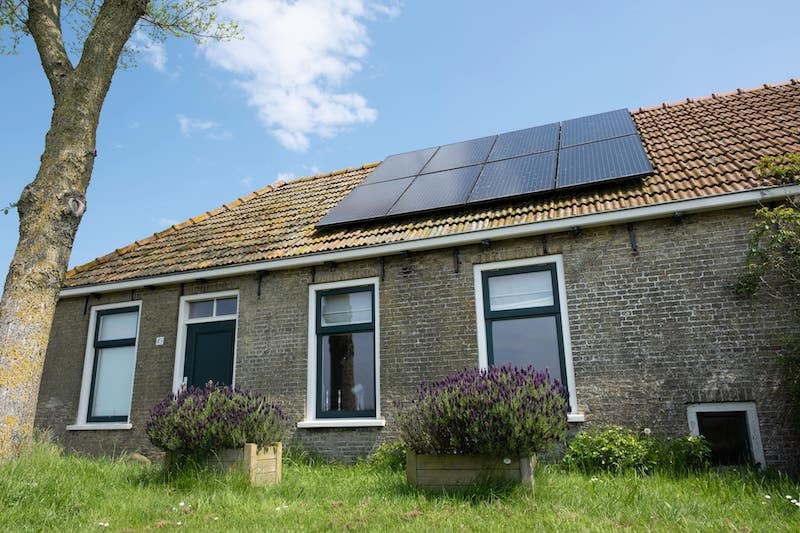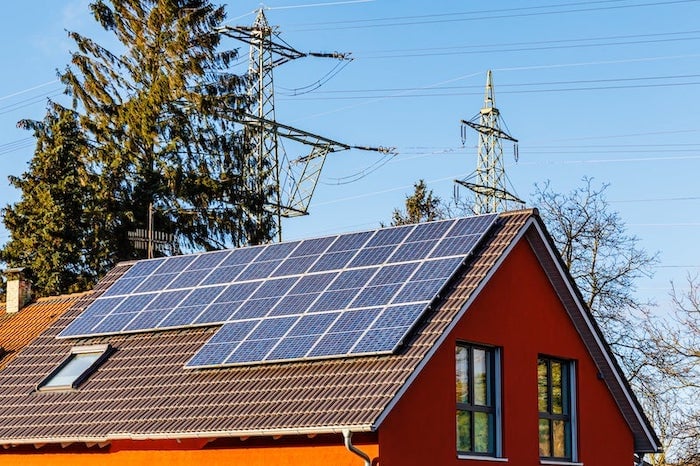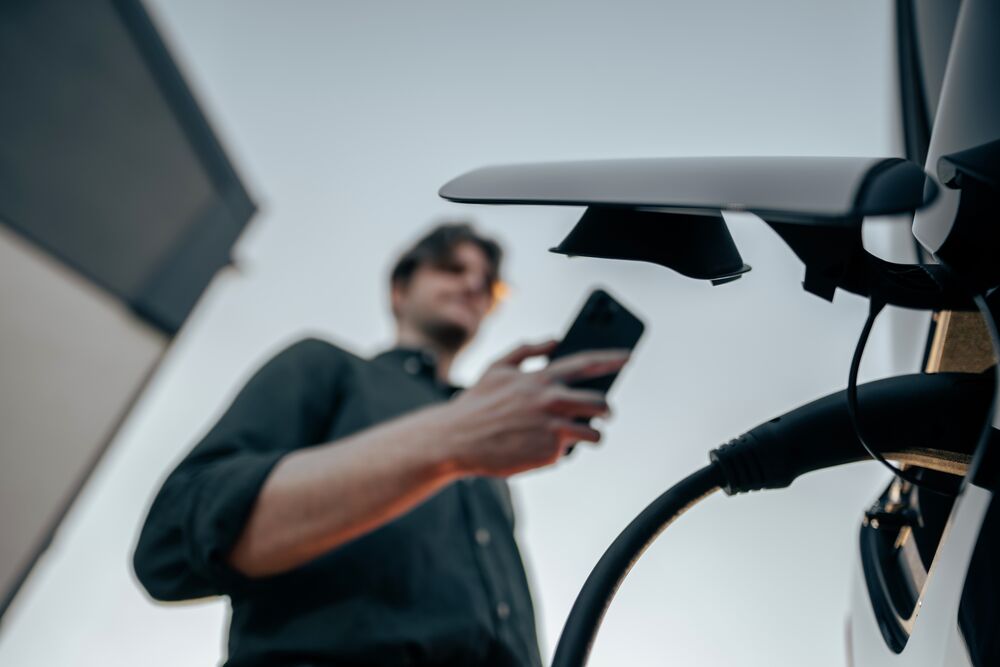rewrite this content between 1000 and 2000 words, add some value and keep HTML tags, translate to brazilian portuguese
Charging your EV at home using the free electricity generated by rooftop solar panels dramatically decreases your carbon footprint. But that’s not the only thing installing a solar EV charging system can positively impact. The cost savings associated with using solar energy for home EV charging can be significant, not to mention long-lasting – the average solar panel comes with up to a 25-year warranty.
Though the initial investment required to install solar at home can be high – and it’s worth noting that there exist numerous rebate and bursary schemes to help you lower these costs – the savings you make charging with solar instead of grid power help offset this investment in the long run.
In this EVBox article on whether solar EV charging can save you money, we address the concerns regarding solar panel investment faced by EV drivers around the world, including whether solar is more economical than grid EV charging, how to minimize the cost of solar charging, and what the potential return on investment is for a home solar EV-charging installation.
Solar panels, are they worth it?
Introducing a solar-powered EV charging system to the home can majorly offset your reliance on grid electricity, lowering your utility bills and carbon footprint at the same time. Of course, the amount of money you can save with solar panels really depends on your particular set of circumstances, including what kind of EV you drive. To know whether solar EV charging could save you money on your utility bills first requires making a few important calculations.

Calculating charging costs
The first step to knowing how much a solar panel EV charging setup can save you is to work out how much it currently costs you to recharge your EV using electricity from the grid.
The best way to do so is to determine your average daily mileage and compare this to your EV’s mileage-per-kWh (kilowatt hour) energy consumption. For the purposes of these calculations, we’ll take the daily average mileage driven by Americans – which is about 37 miles, or 59.5km – and the average energy consumption of the popular Tesla Model 3: 0.147kWh/km.
Using the Tesla Model 3 as our example, the average daily American commute of 59.5km would consume about 8.75kWh of electricity from the EV’s battery. Thus, you’d need to pay for 8.75kWh of electricity from the grid to completely recharge the Tesla at the end of the day.
Our next step is to determine the price of grid electricity in your area. It’s worth mentioning at this juncture that the price of electricity varies wildly from country to country, region to region, provider to provider and, often, depending on the time of day (more on this later). The best way to work out the price you pay your utility provider per kWh of grid electricity is to grab your latest bill. If the bill itself doesn’t clearly detail the per-kWh cost of the electricity supplied to you, then you can calculate it with one simple sum:
Total annual or monthly electricity bill / Number of kWh consumed
(Both of these numbers should be on your utility bill)
For example:
$1,000 / 6,700kWh = $0.1492, or ¢14.92* per kWh
(*This was the average cost of grid electricity per kWh in the US in 2022)
With this figure to hand, now all you need to do is multiply the price you pay per kWh of grid electricity by your EV’s daily recharging needs. Using our example from before, this would work out at:
$0.1492 per kWh x 8.75kWh = $1.31
In this scenario, it would cost the average American Tesla Model 3 driver around $1.31 per day to recharge their vehicle at home using solely grid electricity. Multiplied by the 365 days of the year, the annual home recharging bill for the same driver becomes $478.15. This is also assuming that the driver in our example only ever drives their average commute each day. Wherever longer trips are taken – requiring a fuller recharge – your potential savings continue to increase.

Solar charging cost analysis
Once you’ve calculated the average annual cost of recharging your EV at home, you can begin to determine the kind of cost savings a home solar EV charging system could generate. At first glance, it would seem simple enough to say that, because the electricity generated by solar panels is free, your cost savings would be equal to the amount calculated above: $478.15, for example.
Of course, whilst solar electricity is free, a solar panel system is not. As such, it’s important to weigh your potential cost savings on utility bills against the materials, maintenance, and installation costs of a solar EV charging setup over its lifetime. This figure depends on a few different factors:
Once you’ve determined the overall cost of your solar EV charging system, you can then compare this to the money saved by using free solar electricity to recharge your EV, rather than electricity from the grid. Usefully, consumer survey site SolarReviews has already produced a report on the cost of solar electricity per kWh once levelized against the price of the setup. They calculate the cost of solar electricity to be less than $0.11 per kWh.

Referring back to our example of Tesla’s daily recharging needs, this electricity price drop equates to an annual utility bill of $351.31, compared to $478.15 per year on grid electricity. Thus, switching to solar power to charge your EV would, in this scenario, save you over $125 per year with the costs of your solar EV charging system taken into account.
It’s worth emphasizing at this point that grid electricity elsewhere in the world tends to be significantly more expensive per kWh than in the US and that you are liable to be recharging your EV by more than the battery usage of your average commute on occasion, meaning that your savings could, in fact, be significantly higher.
It is also worth pointing out that few home solar arrays are used solely to recharge EVs. Instead, the majority are used to power both home EV chargers and household appliances, thus diminishing your utility bills even further. For the purposes of this article, however, we will focus exclusively on the cost savings of solar power for EV recharging.

Exploring the factors influencing cost savings from solar EV charging
The amount of money you can save on your utility bills by charging your EV with solar power depends on a number of external factors.
Solar system size and output
The most important of these factors is undoubtedly the size and potential yield of your solar system. After all, the more free, green electricity you can produce at home, the more you can offset your grid electricity consumption by, and the lower your annual utility bill will be.
There are myriad types and brands of solar panels to choose from when building a home solar EV charging array. The quality of your panels, as well as their size – measured in watts – will directly affect how much solar electricity they can produce. The higher efficiency and better quality of their material, the more your panels will be able to convert sunlight into consumable electricity and the faster they will recharge your EV.
Cost savings from optimized solar EV charging systems
Another factor affecting charging costs is the extent to which you ‘optimize’ your solar system. Various optional components, including home energy management systems, smart EV charging software, and battery storage, can all help elevate the energy-production capacity of your panels, whilst reducing utility costs further through smart scheduling, load optimization, shifting, and balancing.

Location
Your location can also play a crucial role in determining your potential cost savings from solar EV charging.
- Different parts of the world are exposed to different amounts of average sunlight. EV drivers living in sunnier areas will tend to require smaller PV arrays to cover their recharging needs and will find that their solar panels generate more electricity, more reliably, compared to the larger arrays required by drivers living in cloudier, colder climes.
- Utility rates differ depending the on electricity supplier and location. For example, whilst the average price per kWh for grid electricity in the USA was around $0.1492 in 2022, in the UK in 2023 the average price was £0.27 per kWh, equivalent to about $0.34, or over double the price. The more expensive electricity is in your area, the greater the potential savings made from switching to charging your EV with free solar power.
Utility rates and time-of-use plans
Utility rates don’t only depend on location and provider, as described above, but can also fluctuate depending on the time of day. If you’ve signed up for a ‘time-of-use’ (ToU) tariff, you’ll benefit from much cheaper prices of grid electricity during off-peak hours, such as between 11 pm and 6 am. In California, to give an example, a ToU tariff may charge the end user $0.60 per kWh at peak energy times, yet just $0.25 per kWh for electricity used overnight.
If you have access to a utility plan like this, you’ll have to factor in how your EV charging behavior compares to the fluctuating price of electricity throughout the day.
Strategies for optimizing solar EV charging times to help you save on utility rates.
Of course, ToU plans are not only beneficial to the EV driver charging their car with power from the grid. Solar panel owners can also benefit by utilizing solar electricity at peak consumption times when the grid is most expensive, and then switching to grid electricity overnight when prices drop. For example, you could elect to continue charging your EV with grid electricity overnight and use your solar panels to power your consumption-heavy household appliances during the day, when electricity prices are at their peak.
To make the most of time-of-use utility plans and solar EV charging, you can schedule your home charging station to operate only when it is most economical, using the connectivity and functionality of a smart charger.

Comparing cost savings from solar EV charging around the world
So far, we’ve modeled cost savings on the basis that you have enough installed solar capacity to cover your EV charging needs wherever you are in the world. Let’s assume, however, that you’ve already got a solar array installed and are therefore limited to charging your EV according to your current solar output. In this scenario, your potential savings from solar EV charging versus grid charging would depend on a few different factors:
We’ve compiled a detailed table below showcasing various examples of annual solar charging cost savings from around the world, taking the above factors into account, and using a model 1.5kW home solar system comprising 5 x 300W panels. We’ve used a range of popular EVs to give a variety of example cost savings, and are basing our calculations on a 30% daily recharge of their batteries. Below each city are two columns, the left column subtracting the electricity our example 1.5kW system could produce on an average day in that area from the right column, which defines how much it would cost to recharge the EV using the average cost of grid electricity in that city. We have converted all currencies into USD for the sake of simplicity.
|
Type of EV |
LOCATION |
|||||||||
|
London |
Los Angeles |
Paris |
Berlin |
New York |
||||||
|
Solar: 5kWh |
Grid: $0.34 |
Solar: 10kWh |
Grid: $0.29 |
Solar: 5.1kWh |
Grid: $0.23 |
Solar: 5kWh |
Grid: $0.37 |
Solar: 7.8kWh |
Grid: $0.21 |
|
|
Tesla Model 3 Long Range Dual Motor (24.6kWh) |
$6.66 per day |
$8.36 per day |
$4.23 per day |
$7.13 per day |
$4.49 per day |
$5.66 per day |
$7.25 per day |
$9.10 per day
|
$3.53 per day |
$5.17 per day |
|
Audi e-tron 55 quattro (28.5kWh) |
$7.99 per day |
$9.69 per day |
$5.37 per day |
$8.27 per day |
$5.38 per day |
$6.56 per day |
$8.70 per day |
$10.55 per day |
$4.35 per day |
$5.99 per day |
|
Fiat 500e Hatchback (12.6kWh) |
$2.54 per day |
$4.28 per day |
$0.75 per day |
$3.65 per day |
$1.73 per day |
$2.90 per day |
$2.81 per day |
$4.66 per day |
$1.00 per day |
$2.65 per day |
|
Ford Mustang Mach-E GT (29.61kWh) |
$8.37 per day |
$10.07 per day |
$5.69 per day |
$8.59 per day |
$5.64 per day |
$6.81 per day |
$9.11 per day |
$10.96 per day |
$4.58 per day |
$6.22 per day |
|
Mini Cooper SE (9.78kWh) |
$1.63 per day |
$3.33 per day |
$0.00 per day |
$2.84 per day |
$1.08 per day |
$2.25 per day |
$1.77 per day |
$3.62 per day |
$0.42 per day |
$2.05 per day |
|
Dacia Spring Electric (8.04kWh) |
$1.03 per day |
$2.73 per day |
$0.00 per day |
$2.33 per day |
$0.68 per day |
$1.85 per day |
$1.12 per day |
$2.97 per day |
$0.05 per day |
$1.69 per day |
|
Average annual savings |
$620.50 saved with solar per year |
$1,058.50 saved with solar per year |
$427.05 saved with solar per year |
$675.25 saved with solar per year |
$598.60 saved with solar per year |
|||||

Long-term financial benefits of switching to solar for EV charging
The savings you make by charging your EV with solar power may vary depending on your circumstances, yet one thing remains constant: the electricity your panels produce will always be 100% free to use. This means that, over time, your savings only accrue, requiring minimal additional financial input as they do.
Over the average lifetime of your solar panels – about 25 years – your savings may likely even increase, relative to the rising costs of electricity from the grid.
Determining long-term savings and ROI from switching to solar EV charging
The return you will see on your investment in a solar EV charging system naturally depends on the cost of the system itself. A fairly basic 1.75kW solar charging setup might cost you somewhere in the region of $6,500, whereas a fully optimized system featuring smart charging and home energy management hardware could cost upwards of $20,000. The former example would, of course, pay for itself much sooner than the latter.
Some estimates place the savings you can make from a basic solar system over its lifetime at around $16,250+. If we are to take the annual savings calculated in our table above – $675.98 per year – and the cost of a mid-range optimized solar EV charging system – $12,000 – then you would estimate that it would take about 17 years to see a return on investment.
However, this calculation is not really accurate, as it is only based on EV charging and doesn’t take other household appliances into account.
According to LCP Delta, a renowned consultancy firm that specializes in the energy transition, a more realistic payback time for your solar rooftop setup will lie somewhere between 5 and 14 years, depending on your location and individual situation.

Conclusion
So, do you really save money with solar panels for EV charging? The answer depends on your setup, your electric car’s charging needs, and your location, but ultimately yes, you really do save money on your utility bills by switching to solar EV charging.
The biggest factor influencing your decision of whether or not to switch will likely be the initial investment required, weighed against your potential cost savings and the length of time before you see a return on your investment. Still, even a basic, relatively affordable solar EV charging system can reduce the price of electricity per kWh to around just $0.11, after material and installation costs are factored in across its lifespan.
The average utility costs saved by solar rooftop generation would pay off an average solar system in around 10 years, leaving you with approximately 15 years to accrue pure profit. In short, solar EV charging is not only convenient and eco-friendly but is also a reliable way of reducing your household outgoings.
To learn more about charging your electric vehicle with solar power, browse our range of other insightful guides on the EVBox blog.






